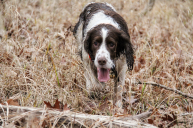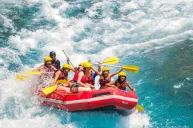With the weather warming and more and more people journeying into the great outdoors, it's an important reminder to be vigilant. Mother Nature, no matter the time of the year, is beautiful, but it can be deadly. You should never go somewhere without a game plan. In some cases, dangers and hazards are easily avoidable as long as you come with a game plan and a bit of common sense. Here are 7 easily avoidable hazards of the great outdoors.
1. Severe Weather In The Outdoors

Photo by Chip Somodevilla/Getty Images
In a lot of cases, severe weather isn't avoidable. But you can avoid being out in it. As they say, April showers bring May flowers. There are certain things you can't avoid (tornadoes, hurricanes, etc). But don't get caught outside or hiking during heavy rain or thunderstorms. These environmental hazards can be potentially dangerous. If you're planning to hit that trail, always check the forecast before and plan ahead.
2. Heatstroke And Heat Exhaustion

Manuel-F-O/Getty Images
The hidden danger of the summer months. I write about heat exhaustion and heat stroke fatalities in the outdoors every year. Don't make yourself my next story. Sweating cools down the body, but it can also cause dehydration (more on this below) and even heat stroke. Be sure to bring plenty of fluids to rehydrate. Also, if you're feeling effects from the sun, seek shade to cool off. Try to avoid hiking during the hottest part of the day (between 3 p.m. and 6 p.m.).
3. Sunburn

Image via Shutterstock
Speaking of the sun, there's nothing worse than coming back from outside and finding yourself plum red. Sunburns are a painful but avoidable hazard of the Great Outdoors. Protect your skin by wearing broad-spectrum UVA/UVB sunscreen. Also try to limit the amount of skin that you are exposing to the sun. Sure, that tan line may look great. But did you know 1 in 5 Americans will be diagnosed in their lifetime with skin cancer?
4. Frostbite

Getty Image
Swapping gears for a second, the cold months have their own dangers. When hitting the outdoors during the winter, try to wear insulated gear and layer your clothing. I also recommend sunglasses to avoid snow blindness. Be sure that you are bundling up properly to avoid losing a finger or a toe.
5. Bug Bites In The Outdoors

Image via Shutterstock
One of the things I hate about spring and summer is all those dang mosquitoes and no see 'ems. Avoid mosquitoes and biting midges by wearing EPA-approved insect repellent. These insects can cause disease, so be sure to to wear some spray in the great outdoors. Also check for ticks!
6. Dehydration

Getty Images, AscentXMedia
As mentioned above, dehydration is an outdoors hazard that can be easily avoided as long as you plan ahead. It's something you can experience year-round, even in colder months. Bring plenty of fluids with you and also remember to replenish your electrolytes as well. Use an insulated bottle to keep your drinks cold in summer and warm during winter.
7. Getting Stranded In The Outdoors

Image via Shutterstock
One of the biggest dangers of being in the outdoors is getting stranded. You can avoid this by charting your trek and not deviating from your plan. Always tell someone where you are going and what time you're planning to come back. It's also not recommended hiking alone.




